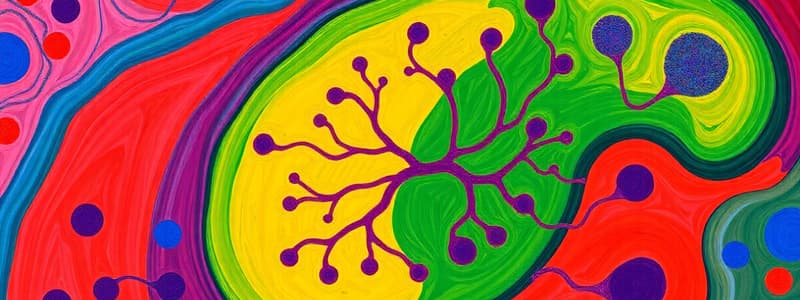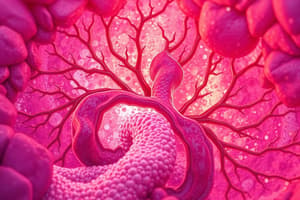Podcast
Questions and Answers
The lymphatic organs play a role in what?
The lymphatic organs play a role in what?
- Nutrient absorption
- Regulation of body temperature
- Digestive processes
- Protection of the body against microorganisms (correct)
Which type of cell is found in large aggregations within lymphatic organs?
Which type of cell is found in large aggregations within lymphatic organs?
- Erythrocytes
- Lymphocytes (correct)
- Adipocytes
- Chondrocytes
What are the two main forms of lymphocytes found in lymphatic organs?
What are the two main forms of lymphocytes found in lymphatic organs?
- Helper cells and suppressor cells
- T-cells and B-cells
- Diffuse lymphocytes and lymphatic nodules (correct)
- Plasma cells and memory cells
Lymphatic tissue is mainly composed of which type of cell?
Lymphatic tissue is mainly composed of which type of cell?
What other types of cells can be found in lymphatic tissue besides lymphocytes?
What other types of cells can be found in lymphatic tissue besides lymphocytes?
What is the structural arrangement of lymphocytes in lymphatic nodules?
What is the structural arrangement of lymphocytes in lymphatic nodules?
What two regions can be identified in a lymphatic nodule?
What two regions can be identified in a lymphatic nodule?
Which of the following is a lymphatic organ?
Which of the following is a lymphatic organ?
Which of these surrounds the lymph nodes?
Which of these surrounds the lymph nodes?
What are the two main regions the lymph node are divided into?
What are the two main regions the lymph node are divided into?
Which part of the lymph node contains lymphatic nodules?
Which part of the lymph node contains lymphatic nodules?
In the medulla, lymphocytes are arranged as what structure?
In the medulla, lymphocytes are arranged as what structure?
The spleen is covered by what type of tissue?
The spleen is covered by what type of tissue?
What structures divide the spleen into incomplete compartments?
What structures divide the spleen into incomplete compartments?
What are the two main parts of the spleen's parenchyma?
What are the two main parts of the spleen's parenchyma?
Which type of pulp contains lymphatic nodules enclosed by a central artery?
Which type of pulp contains lymphatic nodules enclosed by a central artery?
What structure mainly composes the red pulp?
What structure mainly composes the red pulp?
What covering do the tonsils consist of?
What covering do the tonsils consist of?
Which type of tissue is found in lamina propria of tonsils?
Which type of tissue is found in lamina propria of tonsils?
What is formed by the invagination of the epithelium into the tonsils?
What is formed by the invagination of the epithelium into the tonsils?
What type of capsule covers the thymus gland?
What type of capsule covers the thymus gland?
What does the connective tissue capsule of the thymus gland divide it into?
What does the connective tissue capsule of the thymus gland divide it into?
Which area of the thymus contains dark-stained lymphocytes?
Which area of the thymus contains dark-stained lymphocytes?
What type of cells supports the lymphocytes in the cortex?
What type of cells supports the lymphocytes in the cortex?
Lymphocytes in the medulla are what?
Lymphocytes in the medulla are what?
What are the medulla's characterisitic structures?
What are the medulla's characterisitic structures?
What happens to the number of Hassel’s corpuscles during involution?
What happens to the number of Hassel’s corpuscles during involution?
What replaces much of the gland during involution?
What replaces much of the gland during involution?
What happens to the cortex and medulla during involution?
What happens to the cortex and medulla during involution?
What happens to the number of lymphocytes in the cortex during involution?
What happens to the number of lymphocytes in the cortex during involution?
Flashcards
What is the function of Lymphatic organs?
What is the function of Lymphatic organs?
Lymphatic organs protect the body against microorganisms and consist of lymphocytes.
Lymphocyte Aggregation
Lymphocyte Aggregation
A type of lymphocyte arrangement found in two forms: diffuse lymphocytes and lymphatic nodules.
Diffuse Lymphocytes (Lymphatic Tissue)
Diffuse Lymphocytes (Lymphatic Tissue)
Lymphocytes scattered within the Lymphatic tissue, along with macrophages, plasma cells and reticular cells.
Lymphatic Nodules
Lymphatic Nodules
Signup and view all the flashcards
Lymphatic Organs
Lymphatic Organs
Signup and view all the flashcards
Lymph Nodes
Lymph Nodes
Signup and view all the flashcards
Cortex of Lymph Node
Cortex of Lymph Node
Signup and view all the flashcards
Medulla of Lymph Node
Medulla of Lymph Node
Signup and view all the flashcards
Spleen
Spleen
Signup and view all the flashcards
White Pulp of Spleen
White Pulp of Spleen
Signup and view all the flashcards
Red Pulp of Spleen
Red Pulp of Spleen
Signup and view all the flashcards
Tonsils
Tonsils
Signup and view all the flashcards
Tonsillar Crypts
Tonsillar Crypts
Signup and view all the flashcards
Thymus Gland
Thymus Gland
Signup and view all the flashcards
Cortex of Thymus
Cortex of Thymus
Signup and view all the flashcards
Medulla of Thymus
Medulla of Thymus
Signup and view all the flashcards
Hassall's Corpuscles
Hassall's Corpuscles
Signup and view all the flashcards
Main sign of Thymus involution
Main sign of Thymus involution
Signup and view all the flashcards
Study Notes
- This lecture covers the histological structure of lymphatic organs.
- The objectives are to identify the components of lymphatic organs and understand the importance of lymphatic organs in the immunological system.
- Lymphatic organs are important in the immunological system and protect the body against microorganisms.
- Lymphatic organs include the lymph node, thymus gland, spleen, and tonsils.
Lymphocytes
- Large aggregation of lymphocytes can be found in two forms: diffuse lymphocytes and lymphatic nodules.
- Diffuse lymphocytes, also known as lymphatic tissue, mainly consist of lymphocytes, tissue macrophages, plasma, and reticular cells.
- Lymphatic nodules contain lymphocytes arranged in spherical structures or nodules.
- Lymphatic nodules consist of an outer dark region and an inner light center, known as the germinal center.
Lymph Nodes
- The lymph node is surrounded by a connective tissue capsule, with septa or trabeculae, and is divided into the cortex and medulla.
- The cortex contains lymphatic nodules.
- In the medulla, lymphocytes form cords, which are branches and anastomoses separated by medullary sinuses.
Spleen
- The spleen is covered by a capsule of dense connective tissue with smooth muscles.
- The capsule sends septa, also containing smooth muscles, that divide the spleen into incomplete compartments.
- The parenchyma of the spleen is divided into two main parts: white pulp and red pulp.
- White pulp contains lymphatic nodules enclosed by a central artery.
- Red pulp is composed of blood sinusoids.
Tonsils
- Tonsils consist of epithelium (respiratory or stratified squamous) underlined by connective tissue lamina propria, which contains lymphatic tissue and lymphatic nodules.
- The epithelium invaginates deep, forming crypts.
Thymus Gland
- The thymus gland is covered by a connective tissue capsule with septa that divide it into lobules, each with an outer cortex and medulla.
- The cortex contains dark-stained lymphocytes and an extensive population of lymphocytes supported by connective tissue.
- The medulla contains light-stained lymphocytes and consists of several lobules connected together.
- The medulla contains a characteristic structure known as Hassel's or thymic corpuscles, which are acidophilic and have no known function, and no lymphatic nodules.
- The main signs of involution of the thymus gland: the cortex and medulla are destroyed, the number of lymphocytes in the cortex is depleted, the number of Hassel's corpuscles is increased, and the gland is invaded by a large amount of adipose tissue.
Studying That Suits You
Use AI to generate personalized quizzes and flashcards to suit your learning preferences.




